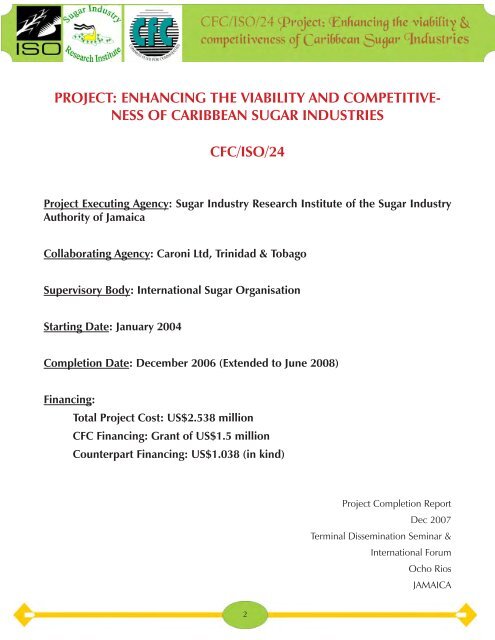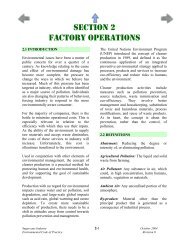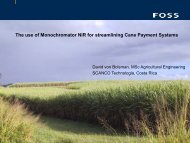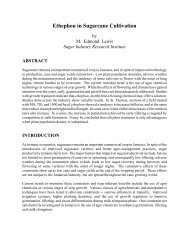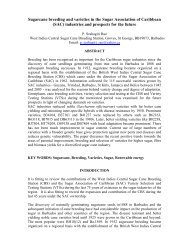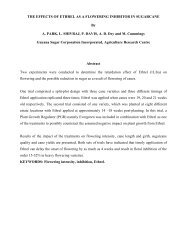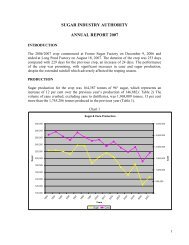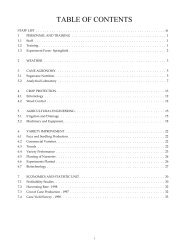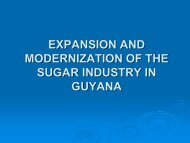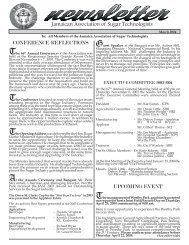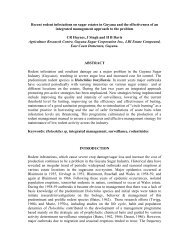Overview - The Jamaican Sugar Industry
Overview - The Jamaican Sugar Industry
Overview - The Jamaican Sugar Industry
Create successful ePaper yourself
Turn your PDF publications into a flip-book with our unique Google optimized e-Paper software.
India, Colombia, Thailand, USA etc had emerged relegating Jamaica’s production to relative insignificance.At its peak, the <strong>Jamaican</strong> industry produced sugar from 18 factories and cane occupied some 60 000 ha. Today (2007) thenumber of factories is down to seven and cane is grown on just about 35 000 ha.From a position of near total dominance of the <strong>Jamaican</strong> economy during the 19th Century, sugar has now declined toapproximately 3% of Gross Domestic Product as it has been eclipsed by other sectors such as tourism and other services,the distributive trade and mining (bauxite mainly).Falling ProductionWith Jamaica becoming an increasingly high cost producer, and sugar being no longer the prized commodity of old, productionhas been falling steadily since the 1960’s. <strong>The</strong> industry has suffered from a lack of investment leading to factoriesoperating on what is now, in some cases, obsolete machinery. Increased input costs have tended to erode profitability.<strong>The</strong>re has been failure (and in some instances inability) to adequately maintain, replace or upgrade field machinery andtransport equipment so that operations become more and more inefficient.With dwindling profitability there has been reduced attention to agronomy leading to lower yields. Consequently, caneyield has fallen from roughly 80 t/ha in the decade of the 1960’s to 75 t/ha in the 1970’s, 65 in the 1980’s to currentlyapproximately 60 tc/ha. Much of the falling standards in agronomy result from a lack of timeliness of operations. Growersmay apply fertilizer but this is often at lower than recommended rates and months after the recommended time ofapplication. Weed control is often neglected or carried out long after the critical time thus allowing cane growth suppression.Drains are often not adequately maintained resulting in waterlogged conditions and suppression of growth. Irrigationcycles which used to number 8-10 per crop in the dry zone, now rarely exceed 3 per crop – even on major estates.Inter-row cultivation, once standard practice, is almost a forgotten practice.<strong>The</strong> industry also suffers a measure of productivity loss associated with the change from green to burnt cane harvestingin the 1960’s (a practice introduced to facilitate mechanical cane loading). Soils therefore no longer enjoy the benefits ofmoisture retention, return of organic matter and weed suppression associated with trash blanketing. <strong>The</strong> replanting cycle,traditionally once every six years, is now closer to 10 or more years for most of the industry. <strong>The</strong> boost in productivityusually associated with replanting is therefore substantially lost.Even as industry yields have declined, there are still remaining pockets of excellence. Worthy park and Cambria farms inSt Catherine perhaps enjoy yields unprecedented in their histories and frequently top the tables at or above 90 tc/ha.Reduced cane area<strong>The</strong> economic downturn manifests itself in more and more farms going out of production and becoming idle. Area reapedhas slipped from some 60,000 in the 1960’s to over 35,800 ha in 2000, to approximately 30,000 in 2007, Table 1. <strong>Sugar</strong>output has correspondingly dropped from approximately 500,000 t, to 216,869 and just over 163, 670 tonnes in 2007over the same period (reaching a low of 124,571 t in 2005, following Hurricane Ivan in 2004).HurricanesA recent spate of hurricanes has only exacerbated the problems. Hurricane Ivan struck in 2004 and was followed byDennis, Emily and Wilma in 2005 and then Dean in 2007. Impact on the industry has been variable but cumulatively theeffect has been demoralising. In addition to crop damage, these have delivered telling blows to infrastructure (factory andfarm buildings, electricity transmission lines, pumping and irrigation facilities, homes etc) and morale.UncertaintyDifficult to quantify, but of undeniable significance, is the level of uncertainty hovering over the industry for the last severaldecades. Each time there is talk of factory closure; growers withhold or delay use of inputs. Attempts at maintenanceare at best half hearted. Expectations of factory divestment have similar consequences as Companies adopt a deliberatestrategy of spending only in essential areas. <strong>The</strong>re is also a strong negative psychological impact from developments in theinternational arena such as the loss of preferential markets, the promised reduction in sugar price on the EU market andmore recently the denouncement of the treaty under which sugar is sold to Europe etc. All such developments discourageinvestment and effort in cane production.5
Fig. 1: Sweet Potato in Crop Rotation with <strong>Sugar</strong> Cane, Westmoreland,JamaicaFig 2 Carrot in Crop Rotation with <strong>Sugar</strong> Cane, Westmoreland, JamaicaFig. 3: Red Kidney Beans in Crop Rotation with <strong>Sugar</strong> Cane, WestmorelandJamaica7Introduction of new irrigation technology (centrepivot) required tapping into water supplies andmodification of structures under the control ofthe National Irrigation Commission (NIC). Thisrequired early and continual consultation andcooperation to achieve a smooth interfacing. Attimes this proved particularly challenging as anumber of participating farmers had outstandingdebt with that institution.RESULTS & DISCUSSIONSConstraintsBy law, all contracts valued above J$4 million(US$1 = J$70), entered into by statutory bodies,such as SIRI, must be approved by Government’sContracts Committee. This proved to be a timeconsuming process which resulted in the contractfor supplying and installing the centre pivot irrigationscheme being awarded so late, a wholegrowing season of potential use was lost. Furtherdelays were caused by the passage of a hurricaneshortly after installation had begun.Of all components, that entailing use of alternatecrops proved most challenging Fig 1, 2 & 3. Unfortunately,Sea Island cotton seed supplied forplanting in the first two years was of low viabilityresulting in poor germination and unacceptablefield populations. In addition, several otheralternate crop plots failed and were abandonedthrough lack of timely basic care from farmerstoo timid (it seemed) to act on their own initiatives.Crop failures also resulted from floodingor wind damage during the period of repeatedhurricane strikes. Growers tended to displaya degree of helplessness and be dependent onthe PEA to carry out the most basic functionsrestricting themselves to only minimal involvement.Along the way, the PEA was forced to shedmany of these growers as they showed little capacityto adapt. Nonetheless, the few outstandingexamples of successful adaptation providedencouragement that diversification may indeedbe profitably achieved. However, many growers,having spent their whole lives in sugar cane, werefound to be not readily adaptable to provide themuch greater level of dedication and attention todetail required for successful alternate crop production.UncertaintyMeanwhile, the project was conducted during aphase of active negotiation for divestment of theGovernment-owned estates to private interests.
<strong>The</strong>se estates then displayed what may have been interpreted as hesitance towards major development which was easilyseen by farmers. This created a wait-and-see attitude among farmers that was not conducive to focussed effort. <strong>The</strong> PEAoften had to step in to rescue plots which were being neglected along with the rest of the farm. To operate within such anatmosphere of farmer uncertainty proved particularly difficult. In some instances, farm abandonment by growers actuallyset back progress as some originally selected for observation (as in the Farm Viability study – Component 6) went out ofproduction thus interrupting the continuity essential for a meaningful data collection and analysis.Grower InvolvementAfter the first year it was found necessary to add another important selection criterion – the participating farmer mustdemonstrate a willingness to commit some of his own resources to the project. <strong>The</strong> latter came about as it was observedthat some growers were prepared to stand back and depend on the project team to carry out every single operation. Itwas apparent that such growers were unlikely to gain much from the exercise.Benefits<strong>The</strong> overall goal of this project of achieving a greater contribution from the sugar industry to the economy may nothave been met because of unforeseen developments. However, despite the many challenges, the overall impact of theproject was positive. <strong>The</strong> project has resulted in distribution of new improved sugar cane cultivars across the industryin an unprecedented fashion, especially given the climate of uncertainty and indecision. <strong>The</strong> deliberate targeting of thesmallholder allowed participants to enjoy a level of earnings that would have been otherwise improbable and kept afloatfarms that perhaps would have succumbed to negative economic forces. At the same time the introduction of modernirrigation systems will have lasting impact, not only for those directly benefiting but to the many that would have beenexposed through the process of dissemination of information. Similarly, new technologies in reduced tillage when fullyimplemented should be a less costly alternative in land preparation. Meanwhile, the walk-behind tractors allow for a degreeof mechanisation in areas uneconomic or just simply inaccessible to conventional tractors.SustainabilityOf major concern was the possibility that the modern centre pivot irrigation system installed would fall into disrepairshortly after the project ended for lack of maintenance. This is a large investment in a 300 meter long machine on wheelswith electrical parts, hoses etc which in time will go bad. <strong>The</strong>re are monthly electricity and water bills that must be paid.Its day to day running also comes at some cost. It was necessary to ensure that after the Funds support ceased the systemwould continue to provide service to the growers.<strong>The</strong> approach taken was to form growers involved into a Water User Group to manage the system. <strong>The</strong> farmers were thusguided into electing an Executive from among themselves, with the SIRI Area Agronomist providing an “oversight” role.Growers agreed to withdrawal of a cess from the value of canes delivered from the project area by the receiving factory.This money was then deposited directly to a bank account and may only be withdrawn by agreement by the group forpurposes of operation and maintenance, payment of electricity and water bills. <strong>The</strong> cess will be subject to review fromtime to time and adjusted if necessary. This device has resulted in the accumulation of a reasonable financial cushion tocarry on operations after the project ends and if maintained should ensure continuity into the foreseeable future.Lessons learnedA significant constraint impinging on the project and on the performance of the wider industry was the approximatedoubling of oil prices from some US$40/barrel in 2004 to over $90 in 2007. Coupled with this was a decline in the valueof the <strong>Jamaican</strong> dollar against its US counterpart from J$60 to the US $ in 2004 to over J$70 in 2007. Together, this triggereda series of increases in input prices, notably in the areas of transportation, fertilizer and herbicides. In the face ofprice increases (and compounded by hurricanes and droughts) the industry tended to reduce its use of inputs resulting ina failure to achieve the productivity gains which were a goal of this project.CONCLUSION<strong>The</strong> CFC project began against the backdrop of major estates having greater access to modern technology. Growers onsmall holdings often lagged behind. Major estates tended to be the ones which first received new improved sugar canevarieties and had a structured nursery programme to facilitate rapid propagation. With economic life of a new varietyextending over some 15 years on average, by the time it got into the hands of smallholders it was often on the decliningend of the performance curve. This project facilitated the new varieties getting in the possession of farmers and estates8
Fig. 4: CFC <strong>Sugar</strong> Cane Variety Nursery plot, Westmoreland, JamaicaFig. 5: CFC Centre Pivot irrigating sugar cane, Content, Clarendon,Jamaicasimultaneously. <strong>The</strong> farmers’ preparedness toplant dibbled tops, as against whole stalks, allowedfor far more efficient use of planting materialthan would normally be achieved on estates.As it turned out, the timing of this projectwas fortuitous in that it permitted developmentof a momentum in variety propagation and distributionjust when activities on Government runestates became curtailed. By the second year ofthe project the major repository of good qualityseed cane of newer varieties in the industry wason farmers’ holdings.Likewise, a number of estates had been adoptingthe highly efficient centre pivot and drip irrigationsystems but these technologies, becausethey involved heavy capital investment, werelargely out of reach and yet to play a part onfarmers’ holdings. This project succeeded inlevelling the playing field somewhat. By groupingcontiguous farms to achieve an economy ofscale, selected growers have been able to benefitfrom the greater efficiencies associated witha centre pivot irrigation scheme.CFC SupportFrom the time of conceptualising, during thedrafting process and throughout its execution theproject received enthusiastic and invaluable supportfrom the CFC through the Project Manager,Miss Eltha Brown. <strong>The</strong> fund proved to be flexibleand willing to modify elements of the projectas recommended by the PEA. When the threeyears had elapsed before vital pieces of equipmentwas received from overseas suppliers, forinstance, the PEA had no trouble in gaining anextension of several months to complete fielddemonstrations.ISO SupportIn the person of Mr Lindsay Jolly, Economist withthe ISO, the PEA found an extremely receptiveand helpful partner. His reliable support assistedin smooth progress even when the PEA might have not have always adhered strictly to approved procedure, so long as theoverall objective was being met. He clearly saw his role as facilitator rather than stern supervisor.Local SupportThroughout its execution the project received invaluable support and drew favourable comment from the leadership ofthe Cane Farmers Association and received local press coverage on the occasion of the Mid-Term Review. With the presenceof Miss Eltha Brown, Project manager from the CFC and Mr Lindsay, Jolly, Economist, representing the SupervisoryBody, the International <strong>Sugar</strong> Organisation (ISO) the occasion of the mid-term review was used to conduct the officiallaunch of the centre pivot irrigation scheme at Content in Clarendon. <strong>The</strong> event was well attended and exposed growersnot only to modern irrigation schemes (including centre pivot and drip irrigation) but to other aspects of farming includingthe dual row planting system and nurseries of new sugar cane cultivars established under the project. 9


